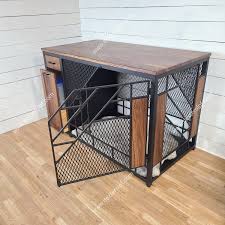The Benefits of Using a Dog Crate
A dog crate is a valuable tool for dog owners that can provide numerous benefits for both the pet and the owner. While some may view crates as confinement, when used correctly, they can actually enhance a dog’s quality of life and improve the overall relationship between the dog and its owner.
Safety and Security
A dog crate offers a safe and secure space for your furry friend when you are unable to supervise them. It can prevent accidents, destructive behavior, and keep them out of harm’s way when you’re not around.
Training Aid
Crates are excellent tools for house training puppies or teaching dogs good behavior. Dogs have a natural instinct to keep their den clean, so crates can help in controlling their bathroom habits and reducing accidents in the house.
Travel Companion
A crate provides a familiar and safe environment for your dog when traveling by car or other means of transportation. It can reduce anxiety and stress during travel, ensuring a more comfortable journey for your pet.
Comfort Zone
Dogs often see their crate as a cozy den where they can relax, sleep, or retreat when they need some alone time. Having their own space can reduce anxiety and make them feel more secure in their surroundings.
Managing Behavior
A crate can be used to manage behavior issues such as separation anxiety, excessive barking, or destructive chewing. By providing structure and boundaries, crates can help in addressing these problems effectively.
In conclusion, a dog crate is not just a cage but a beneficial tool that can improve your dog’s well-being and strengthen your bond with them. When introduced properly and used correctly, a crate can be a safe haven for your pet while offering peace of mind for you as an owner.
9 Benefits of Using a Dog Crate for Your Furry Friend
- Provides a safe space for your dog
- Aids in house training and behavior management
- Offers security when you’re not around to supervise
- Helps reduce stress and anxiety during travel
- Creates a comfortable den-like environment for your dog
- Prevents destructive behavior when unsupervised
- Can be used as a retreat for relaxation and rest
- Assists in managing separation anxiety in dogs
- Promotes a sense of security and routine for your pet
Potential Drawbacks of Using a Dog Crate: Stress, Misuse, and Training Challenges
- Some dogs may initially resist being confined in a crate and exhibit signs of stress or anxiety.
- Improper use of a dog crate, such as leaving the dog inside for extended periods without breaks, can lead to physical discomfort or emotional distress.
- Inconsistent or incorrect crate training methods may result in the dog associating the crate with punishment rather than a safe space.
Provides a safe space for your dog
A dog crate serves as a secure and comforting sanctuary for your furry companion, offering them a designated safe space where they can feel protected and at ease. This enclosed environment provides a sense of security for your dog, allowing them to retreat to their own cozy den whenever they seek solace or simply wish to relax undisturbed. By having a dedicated safe space within the home, your dog can find comfort and peace, promoting their overall well-being and sense of security.
Aids in house training and behavior management
Using a dog crate can be highly beneficial in aiding house training and behavior management for your furry companion. The crate serves as a den-like space where your dog can learn to control their bathroom habits and develop good behavior patterns. By confining them to the crate when unsupervised, you can prevent accidents in the house and encourage them to hold their bladder until they are let outside. Additionally, crates can help in managing behavior issues such as excessive barking or destructive chewing by providing a structured environment with clear boundaries for your dog to follow.
Offers security when you’re not around to supervise
A significant advantage of using a dog crate is the security it provides when you are not able to supervise your furry companion. By confining your dog in a crate, you can ensure their safety and prevent potential accidents or destructive behavior when you are away. This sense of security not only keeps your dog out of harm’s way but also gives you peace of mind knowing that they are in a safe and controlled environment in your absence.
Helps reduce stress and anxiety during travel
A significant benefit of using a dog crate is its ability to help reduce stress and anxiety for dogs during travel. The familiar and secure environment provided by the crate offers a sense of comfort and stability, making the journey less overwhelming for the pet. By having their own space to retreat to, dogs can feel more at ease, leading to a calmer and more relaxed travel experience for both the dog and the owner.
Creates a comfortable den-like environment for your dog
A dog crate serves as a cozy den-like space for your furry companion, providing them with a sense of security and comfort. Dogs have a natural instinct to seek out small, enclosed spaces for relaxation and rest, making a crate an ideal retreat for them. By creating a den-like environment, the crate can help reduce stress and anxiety in your dog, giving them a safe and peaceful place to unwind and feel at ease within your home.
Prevents destructive behavior when unsupervised
One significant benefit of using a dog crate is its ability to prevent destructive behavior when your furry friend is left unsupervised. Dogs, especially puppies or those with separation anxiety, may engage in chewing furniture, shoes, or other items when left alone. A crate provides a safe and secure environment where your dog can stay while you’re away, reducing the likelihood of destructive behaviors and keeping both your pet and your belongings safe.
Can be used as a retreat for relaxation and rest
A significant advantage of using a dog crate is that it can serve as a retreat for relaxation and rest for your furry companion. Dogs naturally seek out cozy and secure spaces to unwind, and a crate provides them with a designated area where they can feel safe and comfortable. By having their own peaceful sanctuary, dogs can relax, recharge, and enjoy some quiet time away from the hustle and bustle of the household, promoting their overall well-being and mental health.
Assists in managing separation anxiety in dogs
A dog crate can be a valuable tool in assisting with managing separation anxiety in dogs. By providing a safe and secure space for the dog to retreat to when left alone, the crate can help alleviate the stress and anxiety that some dogs experience when separated from their owners. The den-like environment of the crate can offer comfort and a sense of security, helping the dog feel more at ease during times of solitude. Introducing the crate gradually and positively associating it with pleasant experiences can aid in reducing separation anxiety and promoting a sense of calmness for the dog.
Promotes a sense of security and routine for your pet
A dog crate promotes a sense of security and routine for your pet by providing them with a designated safe space that they can call their own. Dogs are den animals by nature, and having a crate allows them to have a cozy and secure area where they can retreat to whenever they feel the need for comfort or solitude. This consistent environment helps establish a routine for your pet, creating a sense of predictability and stability in their daily lives, which can ultimately reduce anxiety and stress levels.
Some dogs may initially resist being confined in a crate and exhibit signs of stress or anxiety.
When introducing a dog crate, some dogs may show resistance and signs of stress or anxiety. This initial reaction is not uncommon, as dogs are creatures of habit and may feel uneasy in a new environment or confined space. It’s important for pet owners to introduce the crate gradually, using positive reinforcement and patience to help their canine companions acclimate to this new living arrangement. Understanding and addressing their concerns can help alleviate their anxiety and make the crate a comforting and safe space for them in the long run.
Improper use of a dog crate, such as leaving the dog inside for extended periods without breaks, can lead to physical discomfort or emotional distress.
Improper use of a dog crate, such as leaving the dog inside for extended periods without breaks, can have detrimental effects on the pet’s well-being. This practice may lead to physical discomfort due to limited movement and inability to relieve themselves adequately. Moreover, prolonged confinement can result in emotional distress, causing anxiety, stress, and feelings of isolation in the dog. It is essential for dog owners to understand that crates should be used responsibly and in moderation to ensure the comfort and mental health of their beloved canine companions.
Inconsistent or incorrect crate training methods may result in the dog associating the crate with punishment rather than a safe space.
Inconsistent or incorrect crate training methods can have a negative impact on a dog’s perception of the crate. If a dog is consistently punished or scolded when placed in the crate, it may start associating the crate with negative experiences and punishment rather than a safe and comfortable space. This can lead to increased anxiety, stress, and reluctance to enter the crate, ultimately defeating the purpose of using it as a positive training tool. It is crucial for dog owners to follow proper crate training techniques to ensure that the crate remains a secure and inviting environment for their furry companion.




